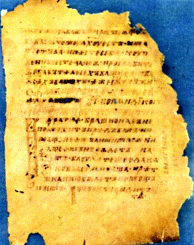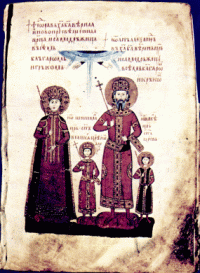
The Cyrillic
The Cyrillic is heir of Glagolica and has more history. There were many affirmations about the change of alphabets; maybe it was don because of the practice. At the period X-XIV century Bulgarians are know both alphabets.
The oldest Cyrillic manuscripts are from the end of X century. In Eninski apostle we can see the connection with glagolick book.
The write at oldest Cyrillic manuscripts is statute. It has symmetry and strictness. The letters are written separately and they have square outline. The text isnít divided in words and has space around the dots. The pressure of pen is even and there are no differences between the lines of letter. At more of manuscripts the handwriting is inclined on right.
At XII century the statute write become to lose its monumentalityís. Often the symmetry is broken and letters are cursive. The words are separated the accents and arranged words are more frequent. The statute write was used until middle of XIV century. It was used for more important religious books. The half statute write was used together with statute write during XIV century. This style is faster. It can be influenced of Bookman habits. Different handwritings are evidences for different schools.
Late statute (named new letter) has influence of the printing types.

Nearly to contemporary handwritten text is the fast writing. On it were written explanatory notes of the general text. It is not for official books but for individual reading work and isnít so widespread.
At Cyrillic are books: Savina book, Eninski apostle, Supraselski collection, Hilendarski pages, Pages of Undolski, Macedonian Cyrillic text. At the same time the apocrypha have development and pervasion.